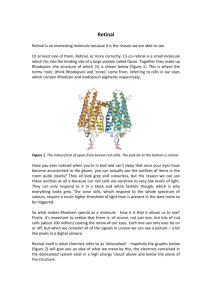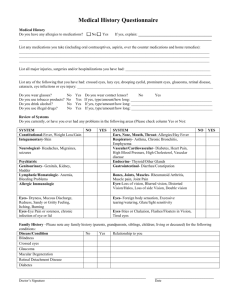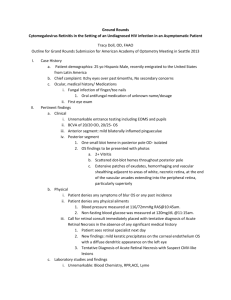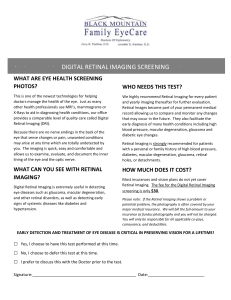140209_Project_Narrative
advertisement
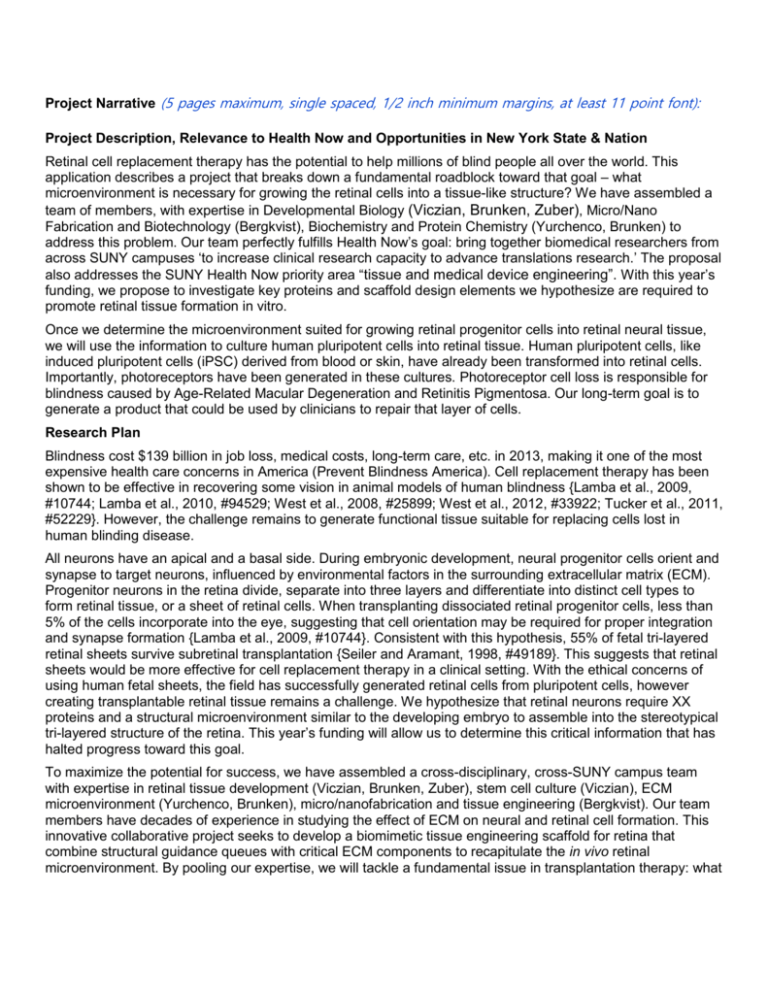
Project Narrative (5 pages maximum, single spaced, 1/2 inch minimum margins, at least 11 point font):
Project Description, Relevance to Health Now and Opportunities in New York State & Nation
Retinal cell replacement therapy has the potential to help millions of blind people all over the world. This
application describes a project that breaks down a fundamental roadblock toward that goal – what
microenvironment is necessary for growing the retinal cells into a tissue-like structure? We have assembled a
team of members, with expertise in Developmental Biology (Viczian, Brunken, Zuber), Micro/Nano
Fabrication and Biotechnology (Bergkvist), Biochemistry and Protein Chemistry (Yurchenco, Brunken) to
address this problem. Our team perfectly fulfills Health Now’s goal: bring together biomedical researchers from
across SUNY campuses ‘to increase clinical research capacity to advance translations research.’ The proposal
also addresses the SUNY Health Now priority area “tissue and medical device engineering”. With this year’s
funding, we propose to investigate key proteins and scaffold design elements we hypothesize are required to
promote retinal tissue formation in vitro.
Once we determine the microenvironment suited for growing retinal progenitor cells into retinal neural tissue,
we will use the information to culture human pluripotent cells into retinal tissue. Human pluripotent cells, like
induced pluripotent cells (iPSC) derived from blood or skin, have already been transformed into retinal cells.
Importantly, photoreceptors have been generated in these cultures. Photoreceptor cell loss is responsible for
blindness caused by Age-Related Macular Degeneration and Retinitis Pigmentosa. Our long-term goal is to
generate a product that could be used by clinicians to repair that layer of cells.
Research Plan
Blindness cost $139 billion in job loss, medical costs, long-term care, etc. in 2013, making it one of the most
expensive health care concerns in America (Prevent Blindness America). Cell replacement therapy has been
shown to be effective in recovering some vision in animal models of human blindness {Lamba et al., 2009,
#10744; Lamba et al., 2010, #94529; West et al., 2008, #25899; West et al., 2012, #33922; Tucker et al., 2011,
#52229}. However, the challenge remains to generate functional tissue suitable for replacing cells lost in
human blinding disease.
All neurons have an apical and a basal side. During embryonic development, neural progenitor cells orient and
synapse to target neurons, influenced by environmental factors in the surrounding extracellular matrix (ECM).
Progenitor neurons in the retina divide, separate into three layers and differentiate into distinct cell types to
form retinal tissue, or a sheet of retinal cells. When transplanting dissociated retinal progenitor cells, less than
5% of the cells incorporate into the eye, suggesting that cell orientation may be required for proper integration
and synapse formation {Lamba et al., 2009, #10744}. Consistent with this hypothesis, 55% of fetal tri-layered
retinal sheets survive subretinal transplantation {Seiler and Aramant, 1998, #49189}. This suggests that retinal
sheets would be more effective for cell replacement therapy in a clinical setting. With the ethical concerns of
using human fetal sheets, the field has successfully generated retinal cells from pluripotent cells, however
creating transplantable retinal tissue remains a challenge. We hypothesize that retinal neurons require XX
proteins and a structural microenvironment similar to the developing embryo to assemble into the stereotypical
tri-layered structure of the retina. This year’s funding will allow us to determine this critical information that has
halted progress toward this goal.
To maximize the potential for success, we have assembled a cross-disciplinary, cross-SUNY campus team
with expertise in retinal tissue development (Viczian, Brunken, Zuber), stem cell culture (Viczian), ECM
microenvironment (Yurchenco, Brunken), micro/nanofabrication and tissue engineering (Bergkvist). Our team
members have decades of experience in studying the effect of ECM on neural and retinal cell formation. This
innovative collaborative project seeks to develop a biomimetic tissue engineering scaffold for retina that
combine structural guidance queues with critical ECM components to recapitulate the in vivo retinal
microenvironment. By pooling our expertise, we will tackle a fundamental issue in transplantation therapy: what
is the optimal scaffold design and ECM proteins necessary to direct bonafide retinal progenitor cells to
assemble into the stereotypical tri-layered structure found in the embryo?
This conceptually simple idea is extremely complex, and the proposed project will provide necessary
information and tools to tackle future projects with embryonic stem cell-derived photoreceptor cells. We
hypothesize that purposely designed tissue scaffolds that mimic the structure and microenvironment found invivo will promote proper retinal assembly in vitro. By developing these scaffolds and materials, it would
represent a critical step for the future clinical success of ocular and neural tissue engineering. We will, in this
effort, focus on investigating the influence on structural guidance and laminin isoforms on development of
retinal progenitor cells toward neural retina tissue. Late-stage and future efforts will incorporate studies on the
role of critical ECM proteins (laminins, etc.) for in vitro photoreceptor development.
1. The design and fabrication of biomimetic 3D tissue scaffolds for retinal sheet generation
A critical structural attachment site for retinal neurons is the inner limiting membrane (ILM), the retinal
equivalent of the cortical pial basement membrane. Structural supports are also needed to guide the columnar
formation of neural retinal cells. Thus porous scaffolds with integrated vertical support structures are needed to
recapitulate these in vivo features. We will develop and fabricate free standing scaffolds with the required
structural components where pore dimensions, pillar width, and spacing will be modulated and cell
growth/development evaluated in subsequent aims. Scaffold designs seek to maximize cell-to-cell contact,
control active area, while providing the cells a structured 3D support surface on which to grow.
We hypothesize that a properly designed scaffold will provide us the structure to grow a stereotypical trilayered retina. For all our experiments, we will isolate and culture RPE cells from the embryonic mouse eye.
The scaffolds generated above will be filled with retinal progenitor cells isolated from the optic vesicle stage
mouse embryo, when retinal progenitors remain in a single neuroblast layer. The retinal cells will be grown on
the scaffold for 21 days with and without RPE cells cultured beneath. The retinal tissue-like cultures will be
fixed, sectioned and stained for expected retinal markers. We will test whether co-culturing with RPE will allow
the extension of outer segments into this tissue, similar as seen in the developing postnatal mouse retina.
2. Orient retinal progenitor cells using fabricated extracellular matrix proteins.
Timeline
Strategy for future growth
Four labs compose the team of researchers needed for this project. As we gather data and a better
understanding of the microenvironment required to generate retinal tissue, we will reach out to experts in the
field for advice, collaboration and expansion. Having this award would lead to preliminary data essential for
obtaining R01 funding, which would allow us to hire more postdoc, graduate students and technicians. As
future problems need solving, we would continue to expand our network of scientists.
Sustained funding
This year of funding will provide the necessary preliminary data for an R01 application to study the effect of
scaffolds on retinal photoreceptor assembly and orientation. In the future, we plan to collaborate and obtain
funding with human stem cell biologists to generate scaffolds containing human photoreceptor cells.
Describe individual team member contributions to the research efforts and project organization
Andrea S. Viczian, PhD (SUNY Upstate Medical University)
Dr. Viczian has expertise in retinal development and mammalian cell culture. Her has studied both cone
photoreceptor gene regulation and formation. As a postdoc, she discovered the first transcription factor
capable of specifying retinal progenitor cells toward a photoreceptor lineage. In collaboration with Dr. Michael
E. Zuber, they also discovered that the eye field transcription factors (EFTFs) were sufficient for retinal
progenitor formation from pluripotent cells. Her laboratory has now advanced this technology into a mammalian
system (mouse embryonic stem cells). She established the groundwork necessary for these investigations by
perfecting the mouse early primitive ectoderm culture system in her own laboratory and adapting the
technology we had developed in Xenopus to this mammalian system. She will supervise the culture both the
frog and mouse retinal cell cultures.
Magnus Bergkvist, PhD (SUNY College of Nanoscale Science & Engineering)
Dr Bergkvist expertise lies in nanofabrication, surface chemistry and protein-surface interactions. He has a
chemical engineering degree focused on pharmaceutical industry and a PhD in surface biotechnology. He has
expertise in biotechnology related nanofabrication from his role as facility manager at the Nanobiotechnology
Center at Cornell University (Ithaca, NY) prior to his faculty appointment as faculty at CNSE. Dr. Bergkvist is
also active in the area of micro/nanofabrication for tissue engineering. Materials of interest include soft/hard
polymeric materials and emerging materials for semiconductor fabrication. Dr Bergkvist will supervise the
design, fabrication, and characterization of 3D scaffold structures.
William J. Brunken, PhD (SUNY Downstate Medical Center)
Dr. Brunken is an internationally recognized CNS matrix biologist; his work has centered on the role of laminins
and netrins in retinal development, as well as the role of these molecules in human disease. He has
maintained a funded research program in ocular biology for 28 years; receiving support from the NEI, NSF,
NINDS, and various foundations support. In addition, Dr. Brunken is a recognized institutional leader; he
serves locally at SUNY Downstate Medical Center as the Vice Chair for Research in the Department of
Ophthalmology under his leadership funded vision research rose dramatically from nearly zero dollars in 2007
to over $7 million by 2013. Recently, Dr. Brunken has been recruited to be the Director of the Center for Vision
Research at Upstate, and will have moved to the new Neuroscience Research Building by the start date of this
proposal. In addition, Dr. Brunken spearheaded the development of SUNY wide consortium of eye
researchers, the SUNY Eye Institute. Thus, he has the scientific skills and the organizational skills to contribute
positively to this project.
Peter D Yurchenco, PhD (Robert Wood Johnson Medical School)
Prof Yurchenco is an internationally recognized expert in the biochemistry and biophysics of basement
membranes. His work has included careful analysis of both type IV collagen and laminin polymer formation
including the visualization of these polymers at a molecular level, and the mapping of receptor and componentbinding activities to structural domains of laminins. His work advanced the now dominant working model of
basement membrane assembly and integrated function. In the past ten years, his laboratory group has refined
and extended the model for a number of key interactions, has identified critical cell surface interactions
required for basement membrane assembly in tissues, has introduced and identified roles of laminin
interactions for embryonic stem cell, Schwann cell and kidney differentiation, and has led to insights into how
basement membranes act as signaling platforms to instruct cells. His fundamental findings regarding basement
membrane structure-function relationships are of immediate relevance to the proposed project. In particular his
current and future studies are focused, in part, on the role of the laminin polymer density and stiffness, acting
in conjunction with specific integrin and dystroglycan ligation, in determining cell fate in different tissues and
can be directly related to the retina. He will interact with the rest of the group to specifically address how
basement membranes affect cell function in complex tissue environments, and those mechanisms relates to
the development of biomaterials that recapitulate basement membrane properties for tissue engineering.
Michael E Zuber, PhD (SUNY Upstate Medical University)
Dr. Zuber has investigated the cellular and molecular mechanisms of early eye formation for more than fifteen
years and uses the African clawed frog Xenopus laevis to study eye development. As a postdoctoral fellow, he
discovered a network of transcription factors required for the formation or retinal stem/progenitor cells. The
Zuber lab, in collaboration with the Viczian lab, demonstrated for the first time that pluripotent cells can indeed
be induced to form multipotent retinal stem/progenitor cells with the capacity to not only generate all retinal cell
classes, but even form functional eyes {Viczian et al., 2009, #10058}. This unique tool will allow us to control
and study the mechanisms and requirements of retinal lamination and development for the in vitro experiments
that are outlined in this proposal. Dr. Zuber’s expertise is perfectly aligned with the goals of this project.
Discuss participation of post docs and/or students.
Rob Antalek (50% effort technician, Viczian lab) will isolate and culture mouse retinal progenitor cells
in the scaffolds generated by the Bergkvist team with added ECM proteins from the Yurchenco team.
He will section and stain the cultures. His work will be supervised by A.V.




